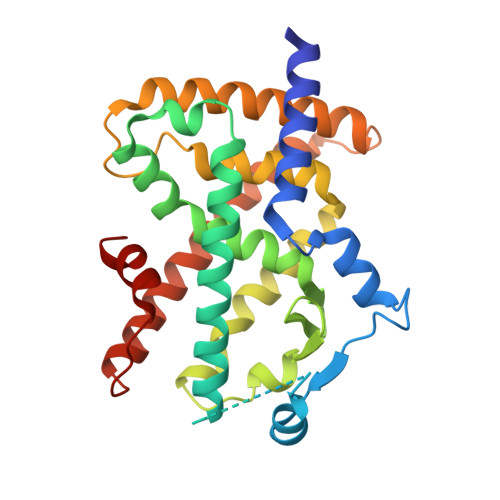Medium chain fatty acids are selective peroxisome proliferator activated receptor (PPAR) Gamma activators and pan-PPAR partial agonists
Liberato, M.V., Nascimento, A.S., Ayers, S.D., Lin, J.Z., Cvoro, A., Silveira, R.L., Martinez, L., Souza, P.C., Saidemberg, D., Deng, T., Amato, A.A., Togashi, M., Hsueh, W.A., Phillips, K., Palma, M.S., Neves, F.A., Skaf, M.S., Webb, P., Polikarpov, I.(2012) PLoS One 7: e36297-e36297
- PubMed: 22649490
- DOI: https://doi.org/10.1371/journal.pone.0036297
- Primary Citation of Related Structures:
4EM9, 4EMA - PubMed Abstract:
Thiazolidinediones (TZDs) act through peroxisome proliferator activated receptor (PPAR) γ to increase insulin sensitivity in type 2 diabetes (T2DM), but deleterious effects of these ligands mean that selective modulators with improved clinical profiles are needed. We obtained a crystal structure of PPARγ ligand binding domain (LBD) and found that the ligand binding pocket (LBP) is occupied by bacterial medium chain fatty acids (MCFAs). We verified that MCFAs (C8-C10) bind the PPARγ LBD in vitro and showed that they are low-potency partial agonists that display assay-specific actions relative to TZDs; they act as very weak partial agonists in transfections with PPARγ LBD, stronger partial agonists with full length PPARγ and exhibit full blockade of PPARγ phosphorylation by cyclin-dependent kinase 5 (cdk5), linked to reversal of adipose tissue insulin resistance. MCFAs that bind PPARγ also antagonize TZD-dependent adipogenesis in vitro. X-ray structure B-factor analysis and molecular dynamics (MD) simulations suggest that MCFAs weakly stabilize C-terminal activation helix (H) 12 relative to TZDs and this effect is highly dependent on chain length. By contrast, MCFAs preferentially stabilize the H2-H3/β-sheet region and the helix (H) 11-H12 loop relative to TZDs and we propose that MCFA assay-specific actions are linked to their unique binding mode and suggest that it may be possible to identify selective PPARγ modulators with useful clinical profiles among natural products.
- São Carlos Physics Institute, University of São Paulo, São Carlos, Sao Paulo, Brazil.
Organizational Affiliation:

















